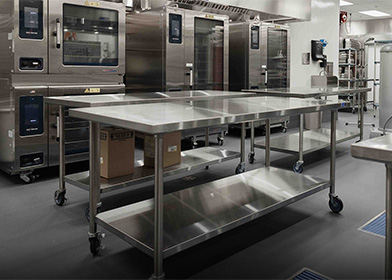
CAPEX PLANNING IN SENIOR LIVING AND HEALTHCARE: WEBINAR WRAP-UP
The following is from our CapEx Planning webinar. If you're interested in watching the webinar on demand, click here.
CapEx is actually short for capital expenditure and refers to funds that a business spends to acquire, maintain or improve long-term assets. This form of company spending is considered an investment that adds economic benefit to operations through increased efficiency or capacity. Long-term assets are usually fixed and non-consumable.
Boelter recently held a webinar in which CapEx was the primary topic of discussion with the focus on Things Senior Living and Healthcare Operators Need to Consider when planning their foodservice capital spend. From identifying who to involve to defining a budget and contingency planning, it was discussed what you should be focusing on every step of the way.
For example, tangible assets such as machinery, buildings, equipment and vehicles and all big-ticket items are CapEx. Software also falls into capital expenses, as do intangible assets like licenses and patents. We also found out that if a permit extends over a few years, then that can be considered a capital expense.
It was discussed that there are a variety of ways in which CapEx can be defined and there isn’t any set metric regarding that. Operators are indeed allowed to set their own guidelines when determining what CapEx is or isn’t for them. Every business is able to manage itself differently and as long as CapEx falls under the category of appreciable assets, things are good.
As with all decisions in the business world, the overall impact of the choices made is atop the list of considerations.
It was highly recommended that decision-makers need to be strategic with whom and how they are making investments. Your choices will have an impact on property valuations and that topic can be broken down into three subtopics.
The first of which is value creation. This concept will bring about engagement with residents, patients, staff and visitors who come into your location. These factors can improve value and engagement while also setting your business apart in the market.
Now that people are in your building, you want to treat them well. It’s the whole ‘Do unto others as you’d have done to you’ concept. There is evolution in the senior living industry and shifting demographics. The expectation comes about that while improving the customer experience may not directly impact your bottom line, a positive customer experience will have great value to your marketing, branding and perhaps even the overall value of your asset.

Creating New Revenue Paths
If you have the facility available and team members who are willing to assist, another potential revenue path awaits. You are spending money to make money. It’s all based upon having the profit mindset and creating more revenue.
For example, take an empty location in the lobby and add a coffee shop or sweet shop. Residents and visitors can have an excellent cup of coffee and chat with each other while also strengthening the company’s coffers.
Or if a coffee shop isn’t the company’s cup of tea so to speak, there are other opportunities available to generate revenue and make better use of the space.
One example cited was taking a “dead space” and making it into a restaurant with the added bonus of creating a pub/bar concept where people can visit loved ones living in the community in a homey, relaxed setting. People will enjoy that special venue and see their family and friends in a place where everyone wants to be and there is action and fellowship.
Another way in which to create additional revenue and make better use of the space is by turning the kitchen into a catering option. Not only can it serve those living within the community, it also can serve different parts of the area along with other businesses.

Right Place, Right People
Now that creating this new revenue path has been strongly considered, the second topic is determining who needs to be involved in making initial and final decisions and signing checks. In some instances, this is a rather straightforward procedure. However, in other businesses, there are myriad obstacles that need to be cleared before the new construction and renovations may begin.
Obstacle No. 1 is the knowledge base of key decision-makers. In some cases, these folks know exactly what’s taking place in their back of house and foodservice operations and are ready to proceed. There are some, though, where reliance upon other people to make things happen leads to the difficulty of key decision-makers being uncertain about the whole process.
Obstacle No. 2 is a lack of operational input. If decision-makers don’t go to the front lines or communicate with those people who have an excellent grasp of the day-to-day operations, things may not be done in the proper manner or even completed at all.
Should the decision-makers seek and receive the information they need from those who indeed possess it, then correct, accurate decisions likely will be made.
OK, so the chefs and cooks and other food prep personnel have been addressed and their input provided.
But, there is another group of team members whose contributions are also absolutely vital to achieving success: the maintenance department.
After all, when everyone and everything is taken into consideration, this group will play an integral role in determining the day-to-day success (or failure) of the operation.
The engineering of the building must be able to support whatever changes are being implemented. And with the added efficiency of new equipment, is the same amount of electrical power required or can the breaker be changed?
In addition to electricity, there are other utilities to consider such as gas and water. Maintenance must be included in all decisions because if not, then the building won’t support what is being installed.
While it may seem overwhelming at times with so many different pieces of foodservice equipment in an operation, the more data available regarding maintenance and repairs will allow for smarter decisions to be made.

Buy, Buy, Buy or Lease Equipment?
Now that the money has been figured out and the new equipment found, there’s a decision to be made as to whether the company buys or leases.
Which is better?
Some people believe leasing is better so the item can be fixed when necessary. However, there are also downsides to leasing such as it making sense to do so and bringing in the right equipment. Some people believe owning can be better if the situation is right.
Another potential detriment of leasing is the dysfunctional item may not be repaired as quickly as you had hoped. Owning the machine and making your own repairs may expedite the process.
In case you were wondering, the two pieces of kitchen equipment needing the most attention are typically ice machines and dish machines.
Dish machines because of their high degree of chemical usage are a concern. So much so that some manufacturers have provided calculators where operators can plug in information such as how long are they using it, what type of machine it is and how many hours a day is it running to provide data in determining whether to rent or own.
There is even a lease-to-own provision in which the senior living facility makes payments and uses the calculator to determine the life span of the machine. It is recommended that buying is better simply because over a four-to-five-year span, a large sum of money is spent on chemicals as well as water.
Whether a facility chooses leasing or owning, there are an abundance of resources and calculators available to assist in the decision.

Coming up Next
So the new equipment is installed and the operation is running quite smoothly. However, keep in mind that the growth of the company individually and the industry as a whole will assuredly have an impact on any and all future decisions.
Chances are good that once the growth begins, it will happen quickly. As a result, accurate assessments and proper feedback from those in the know on the frontline are crucial for further success – especially as the company gets larger.
Two or three units and one person can handle it. Twenty or thirty units, however, and the establishment of a process and knowing who the decision-makers are becomes of the utmost importance.
The meals are being served. The drinks are perfect. Customers and employees are happy. But then one day, some of the equipment starts to fail. Things need to be replaced or repaired.
And then you do what?
If you have a proactive replacement plan, life will be a lot easier than not having the plan. By planning over a three-to-five year span to replace some equipment and get ahead of the process, there can be an avoidance (hopefully) of emergencies popping up in the future.
The importance of being ready for anything to happen with machinery and equipment cannot be overstated.
If something happens and you’re prepared for it and compiled it into the budget, things should be fine. However, if something happens for which you’re not prepared, one of the most important things that can be affected is the menu.
If something catastrophic happens at the last minute, the lead times needed to repair and/or replace can be longer – much longer – than expected especially if your firm is not working with a partner to figure out what’s the issue.
Budgeting can be created that will allow businesses to craft install plans that provide a timeline of what needs to be replaced and when that has to happen.
But who makes the decision of when, what and how much to spend?
Enter the team with representatives from various areas around the company assigned specifically to create capital plans.
Employees from maintenance, foodservice, finance and administration can gather with others to develop the schematic for how much money will be spent and what will be purchased. Maintaining a structure is key as is having the team be multi-tiered so there can be input received and final decisions made. Clarity in processes, procedures and guidelines will be beneficial for all involved.

Glad to be of Service
One last topic of importance covered was how capital planning impacts staff retention and efficiency. It was said that the goal behind any capital plan is not to make things more difficult for the staff and that improving workflow efficiency and creating spaces for the staff is paramount.
While some operators in new communities have chosen not to invest in a breakroom for staff, it’s recommended that any spaces converted should have employees’ wellbeing and benefits in mind.
Along with happier team members, other positives include additional revenue opportunities and improved marketability within the community. With that arrives an increase in brand awareness and by becoming more restaurant-oriented, different staff members and culinarians will be interested in working for the company.
In all, there are a number of ways that looking at how the capital budgets are built have an impact on staff and retention.